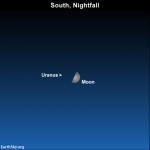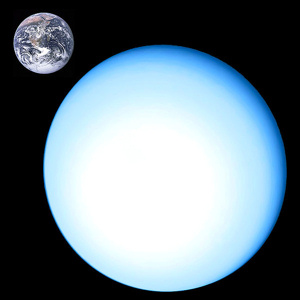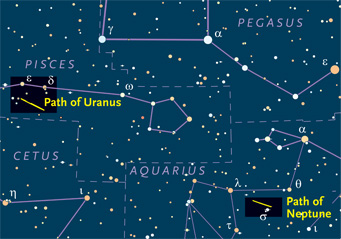

Although Uranus looks like a faint star, even through binoculars, that’s only because this distant world resides in the outskirts of the planetary system, at about 19 AU from the sun. Uranus’ diameter is actually four times greater than Earth’s diameter, and its surface area some 16 times greater than that of Earth.
Tonight – December 28, 2014 – as darkness falls, the moon will be at or near its half-lit first quarter phase. It’s also rather close to the planet Uranus on the sky’s dome. Just don’t expect to see Uranus by the moon this evening – at least with the unaided eye. On a dark, moonless night, practiced sky watchers with exceptional vision can barely perceive this planet as a faint speck of light. In the moon’s glare … probably not.
Yet you might be able to spot Uranus with binoculars. It’s not far from a prominent asterism or pattern of stars called the Circlet in Pisces. At nightfall on December 28, Uranus lies to the east of the moon. That’s fortunate, because the dark side of the moon is facing Uranus, meaning less lunar glare.
After the moon comes out at nightfall, the moon will be moving eastward (toward Uranus) on the sky’s dome throughout the evening hours. That motion is due to the moon’s own motion in orbit around Earth. In the meantime, both the moon and Uranus will be crossing the sky westward, as Earth spins underneath the sky. From the most of North America, the moon will pass to the north of Uranus on our sky’s dome. In other words, no occultation of Uranus from the continental U.S..

Uranus and Neptune are Pisces and Aquarius, respectively, from 2014 through 2017. Chart via skyandtelescope.com
If you live in Alaska or northwestern Canada, however, the moon will occult – pass in front of – Uranus on the evening of December 28. Those living in Anchorage, Alaska, can expect the moon to transit – climb highest up for the night – on this date at 7:15 p.m. Alaska Standard time (AKST). Start watching then, as the occultation will start about 20 minutes later. Uranus will be covered by the moon, as seen from Alaska or northwestern Canada, for about 50 minutes.
Of course, Uranus is a mighty gas giant planet in the outer solar system. It is much, much larger than our moon. It only appears small enough to be covered by the moon because of the moon’s closer distance. Uranus, the seventh planet outward from the sun, resides nearly 20 astronomical units away from Earth. That’s about 8,000 times farther than tonight’s moon.
Bottom line: As darkness falls on December 28, 2014, the moon is at or near its first quarter phase and shines quite close to the planet Uranus on the great dome of sky.
Donate: Your support means the world to us
Live by the moon with your 2015 EarthSky lunar calendar!
from EarthSky http://earthsky.org/tonight/first-quarter-moon-near-planet-uranus-evening-december-28


Although Uranus looks like a faint star, even through binoculars, that’s only because this distant world resides in the outskirts of the planetary system, at about 19 AU from the sun. Uranus’ diameter is actually four times greater than Earth’s diameter, and its surface area some 16 times greater than that of Earth.
Tonight – December 28, 2014 – as darkness falls, the moon will be at or near its half-lit first quarter phase. It’s also rather close to the planet Uranus on the sky’s dome. Just don’t expect to see Uranus by the moon this evening – at least with the unaided eye. On a dark, moonless night, practiced sky watchers with exceptional vision can barely perceive this planet as a faint speck of light. In the moon’s glare … probably not.
Yet you might be able to spot Uranus with binoculars. It’s not far from a prominent asterism or pattern of stars called the Circlet in Pisces. At nightfall on December 28, Uranus lies to the east of the moon. That’s fortunate, because the dark side of the moon is facing Uranus, meaning less lunar glare.
After the moon comes out at nightfall, the moon will be moving eastward (toward Uranus) on the sky’s dome throughout the evening hours. That motion is due to the moon’s own motion in orbit around Earth. In the meantime, both the moon and Uranus will be crossing the sky westward, as Earth spins underneath the sky. From the most of North America, the moon will pass to the north of Uranus on our sky’s dome. In other words, no occultation of Uranus from the continental U.S..

Uranus and Neptune are Pisces and Aquarius, respectively, from 2014 through 2017. Chart via skyandtelescope.com
If you live in Alaska or northwestern Canada, however, the moon will occult – pass in front of – Uranus on the evening of December 28. Those living in Anchorage, Alaska, can expect the moon to transit – climb highest up for the night – on this date at 7:15 p.m. Alaska Standard time (AKST). Start watching then, as the occultation will start about 20 minutes later. Uranus will be covered by the moon, as seen from Alaska or northwestern Canada, for about 50 minutes.
Of course, Uranus is a mighty gas giant planet in the outer solar system. It is much, much larger than our moon. It only appears small enough to be covered by the moon because of the moon’s closer distance. Uranus, the seventh planet outward from the sun, resides nearly 20 astronomical units away from Earth. That’s about 8,000 times farther than tonight’s moon.
Bottom line: As darkness falls on December 28, 2014, the moon is at or near its first quarter phase and shines quite close to the planet Uranus on the great dome of sky.
Donate: Your support means the world to us
Live by the moon with your 2015 EarthSky lunar calendar!
from EarthSky http://earthsky.org/tonight/first-quarter-moon-near-planet-uranus-evening-december-28

Aucun commentaire:
Enregistrer un commentaire